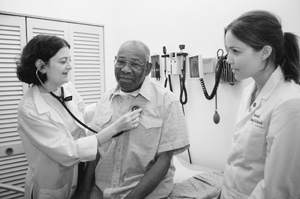Third-year medical students participating in a pilot go on rounds in the Neurosciences ICU with Galen Henderson, MD, at right. Erik Alexander, MD, fourth from right, is director of the pilot for BWH.
Harvard Medical School’s first major curriculum reform in 20 years kicked off as the first-year students matriculated at HMS in August.
“It was time to shake up the system,” said Erik Alexander, MD, of Endocrinology and HMS assistant professor of Medicine. “Changes in the care of patients had not fully translated to necessary changes in medical education. It’s clear we need to give medical students a necessary foundation for the future.”
Among many goals of the curriculum reform, one central dogma is to better incorporate clinical experiences into all four years of medical education, rather than only the third and fourth years as has been in the past. Starting with the entering class of 2010, first-year students spend time shadowing doctors at teaching hospitals, including BWH. The second year includes an integrated approach to understanding disease and emphasizes this by placing students into the clinics, where disease really comes to life. In the fourth year of medical education, students now have a chance to expand their knowledge in an area of concentration such as research, education or clinical care. Previously, Alexander said, the fourth-year was often used to complete clerkships that were highly focused on supporting upcoming residency applications, as opposed to expanding each student’s knowledge base. “Now, the fourth year is less about planning for a residency as it is about developing expertise and interest,” he said.
One of the highlights of HMS curricular reform occurs in the third year, now termed the “Principal Clinical Experience.” For the past year, BWH has been piloting methods to improve this third year experience as it represents a critical point in students’ education. Now in the second year, these pilots will be complete by 2008, when the now first-year students enter their third year.
“The changes being made are substantial and meaningful to their education,” said Alexander, who directs BWH’s Principal Clinical Experience. “Students will spend their entire third year of medical school centered at one teaching hospital rather than completing clerkships at different hospitals throughout the year.”
The clinical clerkships were remodeled so students still immerse themselves in the specialty they are rotating through, while gaining encouragement to think about patient care in a multidisciplinary way. “They are encouraged to think about disease in the broadest sense and reach out beyond the usual boundaries set by the traditional clerkship structure,” Alexander said.
Staying in the same hospital for a year enables the students to gain a better understanding of the multidisciplinary nature of medicine. “They see that people with illnesses usually do not see just one specialist or even just one doctor,” Alexander said.
Each student is also assigned to a faculty mentor who tries to build on their strengths and address their weaknesses throughout the year. Also, students are paired with a resident physician to enhance their comfort with the hierarchy of such a complex medical center.
In June, BWH completed its first year of the pilot with 12 third-year students who volunteered to participate. “They felt very comfortable after spending a whole year at one hospital,” Alexander said. “Students were more apt to independently reach out and expand their own knowledge. In this fashion, they began to build on their learning experiences and clerkship experiences to a greater degree than we have seen previously.”
A new pilot began in July at BWH with 24 third-year students who volunteered for this program. “We’re very excited about the year ahead, and all the potential that such a major curricular reform can bring to the education of these very talented students,” Alexander said.

First-year medical student Ashley Lewis, at right, last month shadowed Lori Wiviott Tishler, MD, as she cared for patients, including Phillip Boucaud, center, at Brigham Internal Medicine Associates.